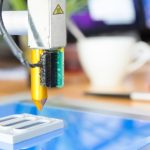
The term 3D printing has been a constant buzzword in the tech scene for quite a few years now. It has seen applications in Aerospace, Housing, and even quite a few industries where automation is applicable.
WHAT IS 3D PRINTING?
3D Printing is a process for making a physical object from a three-dimensional digital model, typically by laying down many successive thin layers of material. It brings a digital object (a CAD representation) into its physical form by adding materials, layer by layer.
There are several different techniques to 3D Print an object. We will go into further detail later in the guide. 3D Printing brings two fundamental innovations: The manipulation of objects in their digital format and the manufacturing of new shapes by the addition of material.
HOW DID IT START?
Discovered in 1984 by Charles Hull, 3D printing or Additive Manufacturing has its roots set deep in history. Initially known as Stereolithography, the process was one of the most pioneering pieces of technology at the time and set the tone for the years to come, about technology.
Although this process made an early debut, it wasn’t until 2009 that the first 3D printer was available for commercial purposes. Cut to the modern day and some hail 3D printing as a part of the 4th Industrial Revolution or Industrie 4.0.
DIY 3D PRINTERS
There is the belief that shortly, everyone will be able to make 3D objects using inexpensive desktop equipment. Nexgen delivers daily 3D printing insights. Nexgen is a great place for DIY 3D printing in Chennai, this also explains you with buying the guide for equipment, software, 3D models, and materials which are extremely easy for you to understand.
DIY printer kits are cheap but, it delivers good-quality prints. But assembling the parts may take time and patience. DIY printer kits cannot be easily used without having an idea of what it is. It may require a certain level of skills. Nexgen will allow you to learn how to build your machines by giving you a list of great but cheap DIY 3D printer kits.
If you want to build your 3D printing kit you have to decide what type of 3D printer you want to build. The more features you want in your DIY printers will be more difficult to create your machine. You should build the basic model in the initial stage and it is best to add more features according to your needs over time. While using a 3D printer builder kit, all the parts have to be built by the machine, which includes in the kit.
If you are starting from scratch you have to be creative to get the parts so that you will get your dream design. Alumide is used to make several parts in 3D printing, which is used to bend the hard particles. Alumide is grey but these colors can be changed with the help of dye colors and change according to our preferences. Before going into the process research has to be done to make sure the process is being done correctly to build your dream design.
Researching the parts is important for any new user to build their printers and buying second-hand parts will help you to save a lot by getting the same performance that you expect from your printer. However, there are some parts that you need to buy new to ensure a smoothly-functioning machine. You can learn all the details of 3D printing with Nexgen.
HOW DOES IT WORK?
Several different processes are involved with different materials which define the outcome of the particular process used. The different types of technologies involved in 3D printing are:
- SLS
- FDM
- DLP
- Inkjet, etc.
The materials used
In the process of 3D printing, the materials are fed into the 3D printer in the form of filaments. The common materials that are used are:
- Plastics
- Ceramics
- Metals
- Bio Materials
- And even, Food.
3D PRINTING SOFTWARE
The files to be printed are usually uploaded in the STL format. Other than that, some of the most commonly used 3D printing software are Cura, Slic3r, and FreeCAD. The process: Once the filaments are fed into the 3D printer, the fed filaments are heated to a certain temperature where they are then extruded through the nozzle, layer upon layer, to form the user’s desired product.
THE FUTURE OF 3D PRINTING
We might say that 3D printing technology is the future. With the emergence of multiple environmental laws all around the world and companies placing focus on cutting costs, through automation and other processes, the 3D printing technology is well on its way to becoming one of the mainstay technological advancements to have been introduced in the past decade. It is projected that by 2026, the industry of 3D printing, technology and services will grow to almost 43 Billion USD at a conservative estimate.
The future is indeed exciting for the 3D printing community, as well as the industry itself.
What do you think the future holds for it?



